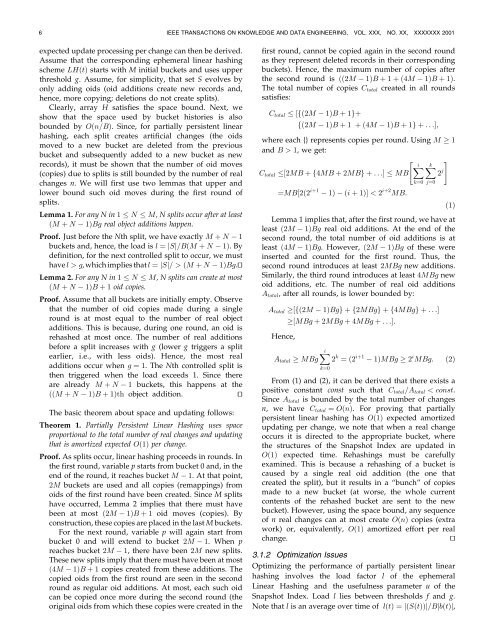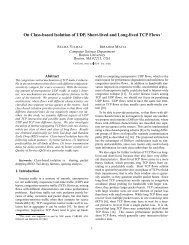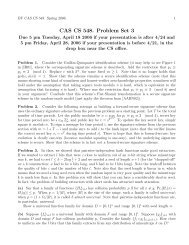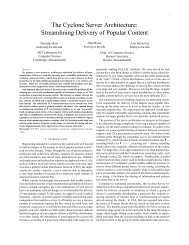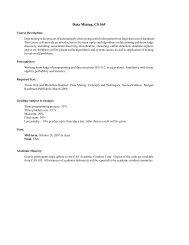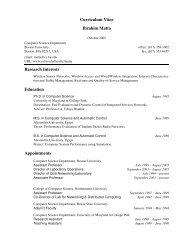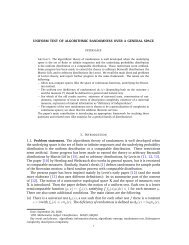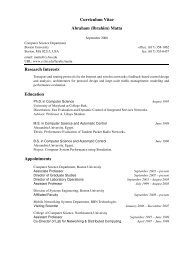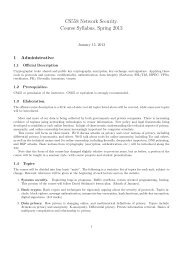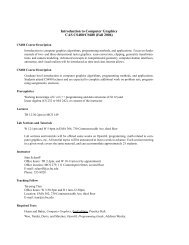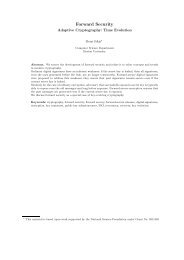Hashing Methods for Temporal Data - Computer Science - Boston ...
Hashing Methods for Temporal Data - Computer Science - Boston ...
Hashing Methods for Temporal Data - Computer Science - Boston ...
Create successful ePaper yourself
Turn your PDF publications into a flip-book with our unique Google optimized e-Paper software.
6 IEEE TRANSACTIONS ON KNOWLEDGE AND DATA ENGINEERING, VOL. XXX, NO. XX, XXXXXXX 2001<br />
expected update processing per change can then be derived.<br />
Assume that the corresponding ephemeral linear hashing<br />
scheme LH…t† starts with M initial buckets and uses upper<br />
threshold g. Assume,<strong>for</strong> simplicity,that set S evolves by<br />
only adding oids oid additions create new records and,<br />
hence,more copying; deletions do not create splits).<br />
Clearly,array H satisfies the space bound. Next,we<br />
show that the space used by bucket histories is also<br />
bounded by O…n=B†. Since,<strong>for</strong> partially persistent linear<br />
hashing,each split creates artificial changes the oids<br />
moved to a new bucket are deleted from the previous<br />
bucket and subsequently added to a new bucket as new<br />
records),it must be shown that the number of oid moves<br />
copies) due to splits is still bounded by the number of real<br />
changes n. We will first use two lemmas that upper and<br />
lower bound such oid moves during the first round of<br />
splits.<br />
Lemma 1. For any N in 1 N M,N splits occur after at least<br />
…M ‡ N 1†Bg real object additions happen.<br />
Proof. Just be<strong>for</strong>e the Nth split,we have exactly M ‡ N 1<br />
buckets and,hence,the load is l ˆjSj=B…M ‡ N 1†. By<br />
definition,<strong>for</strong> the next controlled split to occur,we must<br />
have l>g,which implies that l ˆjSj= >…M ‡ N 1†Bg.tu<br />
Lemma 2. For any N in 1 N M,N splits can create at most<br />
…M ‡ N 1†B ‡ 1 oid copies.<br />
Proof. Assume that all buckets are initially empty. Observe<br />
that the number of oid copies made during a single<br />
round is at most equal to the number of real object<br />
additions. This is because,during one round,an oid is<br />
rehashed at most once. The number of real additions<br />
be<strong>for</strong>e a split increases with g lower g triggers a split<br />
earlier,i.e.,with less oids). Hence,the most real<br />
additions occur when g ˆ 1. The Nth controlled split is<br />
then triggered when the load exceeds 1. Since there<br />
are already M ‡ N 1 buckets,this happens at the<br />
……M ‡ N 1†B ‡ 1†th object addition. tu<br />
The basic theorem about space and updating follows:<br />
Theorem 1. Partially Persistent Linear <strong>Hashing</strong> uses space<br />
proportional to the total number of real changes and updating<br />
that is amortized expected O…1† per change.<br />
Proof. As splits occur,linear hashing proceeds in rounds. In<br />
the first round,variable p starts from bucket 0 and,in the<br />
end of the round,it reaches bucket M 1. At that point,<br />
2M buckets are used and all copies remappings) from<br />
oids of the first round have been created. Since M splits<br />
have occurred,Lemma 2 implies that there must have<br />
been at most …2M 1†B ‡ 1 oid moves copies). By<br />
construction,these copies are placed in the last M buckets.<br />
For the next round,variable p will again start from<br />
bucket 0 and will extend to bucket 2M 1. When p<br />
reaches bucket 2M 1,there have been 2M new splits.<br />
These new splits imply that there must have been at most<br />
…4M 1†B ‡ 1 copies created from these additions. The<br />
copied oids from the first round are seen in the second<br />
round as regular oid additions. At most,each such oid<br />
can be copied once more during the second round the<br />
original oids from which these copies were created in the<br />
first round,cannot be copied again in the second round<br />
as they represent deleted records in their corresponding<br />
buckets). Hence,the maximum number of copies after<br />
the second round is ……2M 1†B ‡ 1 ‡…4M 1†B ‡ 1†.<br />
The total number of copies C total created in all rounds<br />
satisfies:<br />
C total ‰f…2M 1†B ‡ 1g‡<br />
f…2M 1†B ‡ 1 ‡…4M 1†B ‡ 1g‡...Š;<br />
where each {} represents copies per round. Using M 1<br />
and B>1,we get:<br />
" #<br />
C total ‰2MB ‡f4MB ‡ 2MBg‡...ŠMB Xi X k<br />
2 j<br />
ˆMB‰2…2 i‡1 1† …i ‡ 1†Š < 2 i‡2 MB:<br />
kˆ0 jˆ0<br />
Lemma 1 implies that,after the first round,we have at<br />
least …2M 1†Bg real oid additions. At the end of the<br />
second round,the total number of oid additions is at<br />
least …4M 1†Bg. However, …2M 1†Bg of these were<br />
inserted and counted <strong>for</strong> the first round. Thus,the<br />
second round introduces at least 2MBg new additions.<br />
Similarly,the third round introduces at least 4MBg new<br />
oid additions,etc. The number of real oid additions<br />
A total ,after all rounds,is lower bounded by:<br />
A total ‰f…2M 1†Bgg‡f2MBgg‡f4MBgg‡...Š<br />
‰MBg ‡ 2MBg ‡ 4MBg ‡ ...Š:<br />
Hence,<br />
A total MBg Xi<br />
kˆ0<br />
…1†<br />
2 k ˆ…2 i‡1 1†MBg 2 i MBg: …2†<br />
From 1) and 2),it can be derived that there exists a<br />
positive constant const such that C total =A total < const.<br />
Since A total is bounded by the total number of changes<br />
n,we have C total ˆ O…n†. For proving that partially<br />
persistent linear hashing has O…1† expected amortized<br />
updating per change,we note that when a real change<br />
occurs it is directed to the appropriate bucket,where<br />
the structures of the Snapshot Index are updated in<br />
O…1† expected time. Rehashings must be carefully<br />
examined. This is because a rehashing of a bucket is<br />
caused by a single real oid addition the one that<br />
created the split),but it results in a ªbunchº of copies<br />
made to a new bucket at worse,the whole current<br />
contents of the rehashed bucket are sent to the new<br />
bucket). However,using the space bound,any sequence<br />
of n real changes can at most create O…n† copies extra<br />
work) or,equivalently,O…1† amortized ef<strong>for</strong>t per real<br />
change.<br />
tu<br />
3.1.2 Optimization Issues<br />
Optimizing the per<strong>for</strong>mance of partially persistent linear<br />
hashing involves the load factor l of the ephemeral<br />
Linear <strong>Hashing</strong> and the usefulness parameter u of the<br />
Snapshot Index. Load l lies between thresholds f and g.<br />
Note that l is an average over time of l…t† ˆj…S…t††j=Bjb…t†j,


